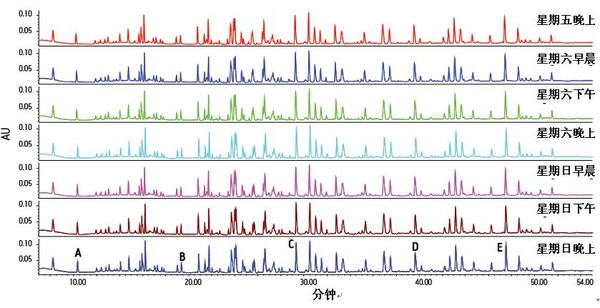Reliability of peptide mapping using ACQUITY UPLC H-Class system

aims
Determine the reproducibility of the analysis of the ACQUITY UPLC® H-Class system in long and shallow elution gradient applications to resolve complex mixtures, such as peptide mapping analysis.
The ACQUITY UPLC H-Class system provides the accuracy and reproducibility of extended batch peptide separation.
background
Peptide mapping is used to confirm the primary structure of a protein, identify post-translational modifications (PTM), and analyze potential impurities. Any differences in protein structure should be reflected in changes in the retention time of the peptide containing the modification. The relative amounts of peptides with and without special modifications are used to determine the proportion or content of protein in a specific sample containing the modification.
The change in area ratio corresponds to the content of protein molecules in the sample containing the specific modification. To meet these application requirements, long and shallow gradient elution is required. In the past these separation conditions were a challenge for single pump gradient systems. In this study, we tested a typical peptide mapping analysis scheme on the ACQUITY UPLC H-Class system.

Figure 1. The sample list for peptide mapping starts on Friday and runs automatically throughout the weekend. When the staff returns to work on Monday, the data is ready for review. The figure shows every three separations, showing excellent reproducibility, resolution and retention time. As outlined in Table 1, the five labeled peaks, from A to E, were selected as representatives of quantitative analysis.
Solution
The ACQUITY UPLC H-Class system consists of a quaternary solvent manager (QSM), flow through the needle sample manager (SM-FTN), column heater, and photodiode array (PDA) detector. An optional 250μL mixer is installed. The standard peptide solution in MassPREPTM BSA reagent was separated on an ACQUITY UPLC BEH 300 C18 reverse phase column. When increasing the elution volume of each bed volume, the elution gradient increases by 1.0% and the gradient increases by about 0.6% per minute. This gradient is selected as the typical peptide mapping gradient.
This solution makes full use of the automatic mixing capability of the instrument. Pure solvent reservoirs and concentrated modifier reserves are used to replace binary, pre-treated solvents. In this example, the gradient is formed in pure water in line A and pure acetonitrile in line B, and a portion of the liquid stream is drawn from water reservoir D containing 1% TFA. In the gradient, the proportion of line D is reduced from 5% to 4%, which is equivalent to a decrease in TFA concentration from 0.05% to 0.04%, thereby minimizing baseline drift.
The peptide map is shown in Figure 1. Table 1 statistically analyzes parameters such as retention time and peak area. The relative retention and resolution remain constant during long series runs. The retention time is sufficiently reproducible to ensure that peaks can always be correctly identified. Using the area of ​​peak A as a reference, compare peaks B, C, D, and E, and calculate the corresponding proportion in each test sample. These area ratios are highly consistent in each test sample (as shown in Table 1), and such accuracy meets our requirements for measuring the ratio of modified proteins in a series of samples.

Table 1. Summary of chromatographic peak retention time and area ratio. The five peaks selected for quantitative comparison are evenly spaced across the entire elution gradient for 10 minutes.
to sum up
For meaningful peptide mapping, both quantitative and qualitative reproducibility are required. The ACQUITY UPLC H-Class system provides precise control for peptide mapping and separation of large samples, making analysts confident in the instrument. I believe that any deviation in retention time means that the sample composition has changed, not caused by instrument variability. of. When this multi-solvent mixing ability is utilized, the observed separation meets this goal. The design of this system ensures that both quantitative and qualitative results meet the requirements of modern analytical biochemistry.
Cooking can sometimes be a real chore and a real bore. And sometimes one just needs to get away from the daily grind and do something different. Natural Gas BBQ Grills are one way of shaking up the breakfast, lunchtime or dinner routine – whether you use them camping, on a family get-together in the outback or simply for the sake of cooking outside, it really doesn`t matter.
Make your business or stores plentiful, Natural Gas Grills have to be your choice. We produce a wide range of Grills, NG Grills and Natural Gas Conversion Kit, and replacement parts are included too.
Natural Gas Grills,Outdoor Gas Barbecue Grill,Natural Gas BBQ Grills,Natural Gas Barbecue
Dongguan Jiangxin Metal Products Co., Ltd , https://www.jiangxinbbq.com